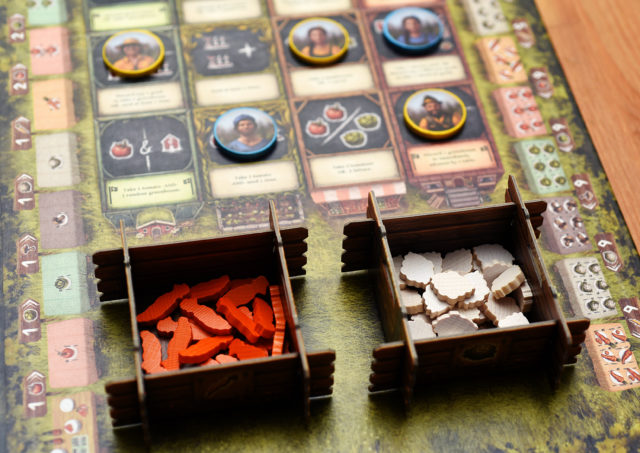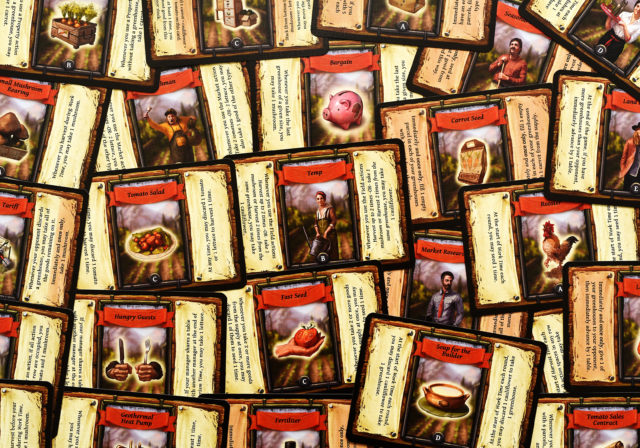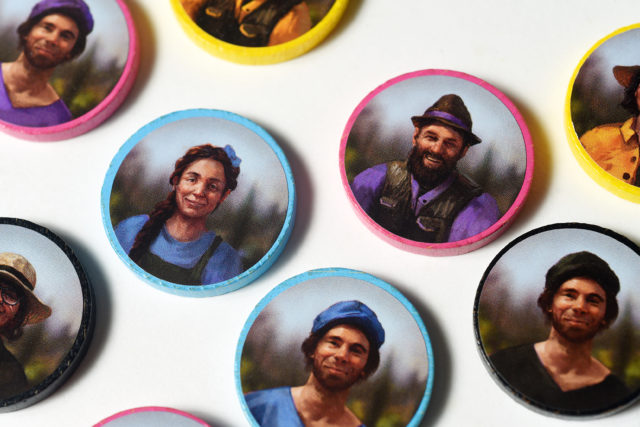Uwe Rosenberg has designed a lot of games. Too many (for me to bother) to count. I gladly own twelve of them, so you could say I’m a fan.
If you peruse Uwe’s oeuvre, you’ll see that many of his games are remarkably similar to each other. He’s got his worker placement games where you have to feed people. He’s got his polyomino games. He’s got a bunch with clever takes on set collection. He’s got some with boards that lose you points unless you fill them up with tiles. And I certainly don’t mind this iterative approach at all. Uwe has proven himself an expert at remixing his own designs. He’s designed five games with polyominoes, and they’re all good to amazing!

But no one is perfect. Uwe has misstepped before, and he will again. It’s the curse of any renowned designer. Of any creative professional, really. You put out enough work, and some of it won’t be great. Reykholt isn’t a bad game per se, but it fails to live up to the designer’s very impressive body of work.
The reason I draw attention to the similarity between Uwe’s designs is that Reykholt borrows quite a bit from his 2009 game At the Gates of Loyang. When I read a description of Reykholt’s gameplay, I quickly became excited, as it borrows one of my favourite parts of Loyang: the vegetable fields (although they call them greenhouses in this game). There are four sizes of greenhouse (3, 4, 5, and 6 spaces). If you plant one vegetable in a greenhouse with 6 spaces, the game fills the other 5 spaces with identical vegetables from the supply. During the harvest phase of each round, you get to take one vegetable from each greenhouse. So, one tomato becomes six tomatoes over the course of six harvests. However, each greenhouse limits what kind of vegetables can be planted in it. Larger greenhouses can only grow tomatoes and lettuce, the game’s more common vegetables. Carrots can only be grown in the greenhouses that are 3 spaces large, making them much more difficult to multiply effectively. I like it. A lot!
What has ol’ mixmaster Rosenberg done to jazz up this mechanism 9 years later?
He gave us an easy to grasp worker placement game for 1 – 4 players that clocks in under an hour. The players acquire greenhouses and vegetables, plant those vegetables in the greenhouses so that they can multiply, harvest the vegetables, and spend them to progress around the score track. Whoever gets furthest along the score track in the span of 7 rounds is the coolest farmer in Iceland.
However, before we get any further into the gameplay, I would like to draw attention to how gorgeous this game is. Lukas Siegmon has outdone themselves in creating a breathtaking, bustling farmer’s market for all of us to enjoy. I look at the bucolic little world they’ve created and I’m tempted to pack up and move to Iceland. The wooden vegetable tokens are as beautiful as they are plentiful, and the game even comes with cardboard ‘crates’ to keep them neatly organized while you play. Cardboard vegetable tokens also come in the box, just in case you run out of the wooden tokens, but that’s unlikely to happen in anything but the last few rounds of a 4 player game.

Each player has 3 workers they will deploy each round. The board has 12–24 spaces to place these workers, depending on the number of players. Those spaces are sorted into four columns, categorized into property actions (acquiring greenhouses), field actions (planting stuff in and harvesting from greenhouses), market actions (acquiring vegetables), and hall actions (gaining access to a special ability or discarding greenhouses to brute force the score track).
Players take turns in clockwise order placing one worker at a time on unoccupied spaces, and performing the corresponding action. You might acquire a greenhouse with your first action, gain some vegetables with your second action, then plant one of them in that greenhouse as your third action.
Once everyone has placed all three of their workers, everyone gets to harvest. Each player harvests once from each of their greenhouses. If a greenhouse is now empty, you’ll have the opportunity to plant in it again next round. If not, that’s great, too; more vegetables are headed your way soon.
Then, everyone takes a turn at paying to progress on the score track, which features the game’s array of vegetables in growing numbers. To progress to the next space, you must pay the depicted vegetables to the supply. The first five spaces are 1 vegetable each, the second set of five are two vegetables each, and so on. And they always appear in the order that respects their relative rarity: tomato→lettuce→mushroom→cabbage→carrot. There’s one really sweet twist, though. Once per round, you gain the vegetables of the next space instead of having to spend them. You could, for instance, pay 1 tomato, pay 1 lettuce, gain 1 mushroom, and pay 1 cabbage to progress 4 spaces. Once you’ve used your bonus move and are unable to pay for the next space, your scoring phase ends.
What I really like about this twist, at first blush, is that it helps you with what you’re lacking. You didn’t have any mushrooms before, but you do now. You only need one more for the next mushroom space. So either plant it or get yourself to the market to grab another.

Unfortunately, the score track is also where Reykholt begins to falls apart. It’s always the same five vegetables in the same order, over and over again. This lack of variance makes every play feel exactly the same. Heck, it makes every round feel the same. The fact that the action spaces are static doesn’t help either. Resource collection games desperately need variance in the demand of its available resources or things get stale fast. Imagine if you played Catan with the same board every time. Imagine if Century Spice Road’s market and demand cards were always presented in the same order. Imagine if Isle of Skye only had four scoring tiles in the box.
In every game of Reykholt, you’re always looking for the same number of vegetables in the same rising quantities. Yes, some of them are harder to acquire or grow effectively, but that doesn’t seem to add any interest or tension to the experience. There are enough action spaces that everyone is able to do some version of what they want to do. In fact, in some cases the game prevents players from taking too many of the same action so that everyone is allowed their fair share. And that’s boring. Taking what other people want is an interesting, even crucial part of the worker placement mechanism. And even if you’re able to derail an opponent’s plans – perhaps choking their mushroom supply – it barely matters. The score track is just going to cough up those mushrooms in a minute, anyway.
At the very least Reykholt is a fairly brisk affair. Each of the 7 rounds are quite brief. Its simplicity, lush art and impressive component quality make it ideal for a family game. Yet, that briskness only draws attention to another issue: Reykholt has an elegant production engine that is never given the chance to blossom into something greater due to the game’s brevity. Just as you’re done ramping up production, having acquired a respectable number of greenhouses and freshly seeded them to keep up with the increasing demands of the score track, a bell rings to signal the beginning of the final round. Players scurry to sell their greenhouses for extra movement on the score track and wonder what to do with the rest of their turn, because none of the action spaces are nearly efficient enough to have kept up with the score track’s plant-based appetite. It almost feels like setting up a game of Agricola and saying “Well, isn’t that pretty… okay, time to pack it up!”
Reykholt does have one element to shake things up with game-to-game variance: the service cards. During setup, you choose one set (roughly 6-8 cards per set), and randomly add 5 of the cards from the chosen set to the game. These cards can be acquired, or even shared, using certain action spaces, and give you either an immediate or ongoing bonus. Unfortunately, the effects of many of these cards are fairly underwhelming. If they were powerful, I could see them having a more significant impact on the game and change the way you approach playing it.

I’m glad that the game is set in Iceland, if for no other reason than that it allowed them to call it Reykholt, which is a great name. It’s a homonym of récolte, the French word for harvest. Reyk is the beginning of Iceland’s capital, Reykjavik. And I’ll choose to believe that holt is a reference to Steve Holt from Arrested Development, despite any evidence I hear to the contrary. But without any appreciable variance from one game to another, the design’s abstract nature becomes painfully apparent. By the end of my first game, the life that the game’s gorgeous artwork had breathed into it had long been sucked out of the room. I’m left wondering what I can do to repurpose these delightful wooden vegetables and their adorable wooden crates.
Reykholt is a gorgeous game. Its simple rules and attractive components will appeal to many. Families and newer gamers will find a compelling introduction to worker placement and resource production. However, experienced gamers who wish for depth and replayability will be better served looking elsewhere.
Reykholt is a worker placement game for 1 – 4 players, that plays in 30 – 60 minutes. Designed by Uwe Rosenberg, with art by Lukas Siegmon, and published by Renegade Games. Thank you to Renegade Games for providing a review copy.
Comments
No comments yet! Be the first!